Nestled amidst the lush greenery of Bali, Penglipuran Village stands as a testament to the enduring spirit of Balinese tradition. This charming village, steeped in history and cultural significance, invites visitors to immerse themselves in a world where ancient customs and sustainable practices harmoniously coexist.
From its unique architectural design to its vibrant cultural heritage, Penglipuran Village offers a captivating glimpse into the heart of Balinese life. Join us as we delve into the rich tapestry of this extraordinary village, uncovering its secrets and celebrating its enduring legacy.
Village Overview: Penglipuran Village
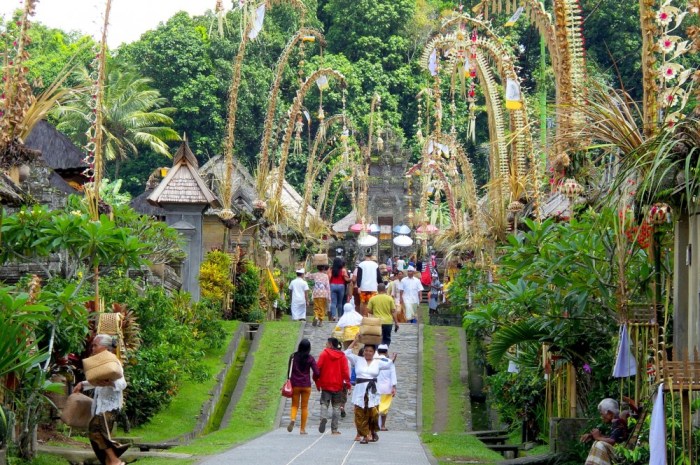
Nestled amidst the lush landscapes of Bali, Indonesia, Penglipuran Village stands as a testament to the island’s rich cultural heritage. With a history dating back centuries, the village has preserved its traditional architecture and customs, earning it recognition as one of Bali’s most well-preserved villages.
Penglipuran Village is a traditional Balinese village located in the Bangli Regency of Bali, Indonesia. It is known for its unique architecture, lush greenery, and traditional way of life. While Penglipuran Village is a popular tourist destination, it is also a great place to experience authentic Balinese culture.
If you are looking for a unique and immersive cultural experience, then a visit to Penglipuran Village is a must. To explore more of Indonesia’s bustling urban life, consider venturing to central jakarta , where you can experience a vibrant blend of modern and traditional Indonesian culture.
Penglipuran Village’s unique layout and architecture reflect the Balinese philosophy of Tri Hita Karana, which emphasizes harmony between humans, nature, and the divine. The village is divided into three sections: the Utama Mandala (sacred center), the Madya Mandala (middle realm), and the Nista Mandala (outer realm).
Each section has its own distinct function and symbolism, creating a harmonious balance within the village.
Traditional Architecture
The traditional houses in Penglipuran Village are constructed using natural materials such as bamboo, thatch, and wood. They feature intricate carvings and decorations that depict scenes from Balinese mythology and daily life. The houses are arranged in neat rows along narrow lanes, with each house facing a central courtyard.
The courtyards are used for various activities, such as cooking, weaving, and socializing.
Cultural Significance
Penglipuran Village is not only a beautiful architectural wonder but also a living testament to Balinese culture. The villagers continue to practice traditional crafts, such as weaving, woodcarving, and painting. They also observe traditional ceremonies and rituals that have been passed down through generations.
The village’s unique way of life has attracted the attention of tourists from around the world. However, the villagers have taken steps to ensure that tourism does not disrupt their traditional way of life. Visitors are required to follow strict rules and regulations when visiting the village, such as wearing traditional Balinese clothing and respecting the villagers’ privacy.
Penglipuran Village, known for its traditional Balinese architecture and lush greenery, offers a glimpse into the island’s rich cultural heritage. A short drive away, the vibrant Seminyak Beach beckons with its upscale boutiques, chic restaurants, and lively nightlife. While Penglipuran Village provides a serene escape into Bali’s past, Seminyak Beach offers a glimpse into its modern cosmopolitan lifestyle.
Cultural Heritage and Traditions
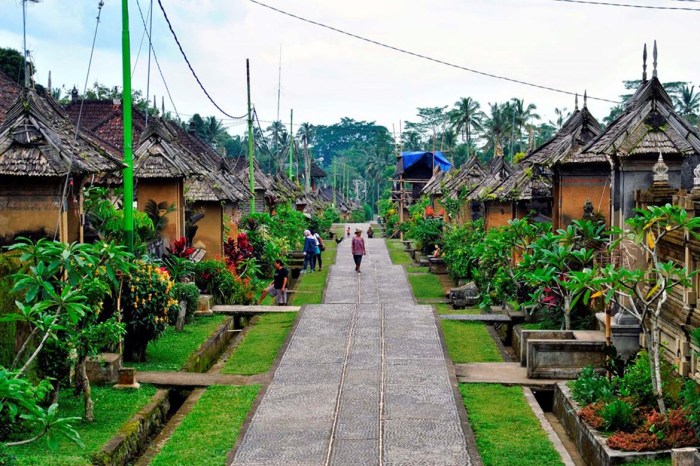
Penglipuran Village holds a rich cultural heritage that is deeply rooted in tradition. The villagers have preserved their customs, ceremonies, and rituals over generations, showcasing their unique identity.
Bamboo Forests
Bamboo forests play a significant role in the village’s culture and economy. Bamboo is used extensively in construction, handicrafts, and even as a source of food. The villagers have developed a deep understanding of bamboo’s properties, utilizing it for various purposes.
The bamboo forests are also considered sacred, and villagers believe they protect the village from evil spirits.
Daily Life and Community
The villagers of Penglipuran live a communal life, with a strong sense of cooperation and mutual support. They engage in traditional farming practices, cultivating rice, fruits, and vegetables. The village is also known for its skilled artisans, who create intricate textiles, wood carvings, and bamboo crafts.
The villagers’ daily routines are centered around maintaining the village’s harmony and preserving their cultural heritage.
Sustainable Tourism and Conservation
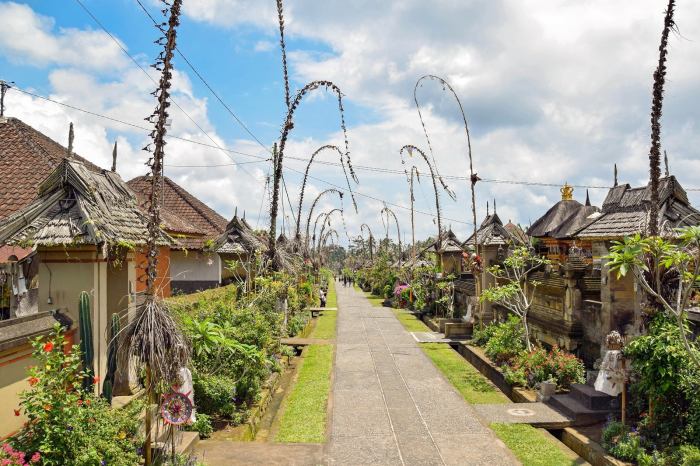
Penglipuran Village is a testament to the successful integration of cultural preservation and sustainable tourism. The villagers have implemented various initiatives to protect their heritage while promoting responsible tourism practices.
Eco-Friendly Practices
Penglipuran has adopted eco-friendly practices to minimize its environmental impact. The village uses biodegradable materials, promotes waste reduction, and relies on renewable energy sources such as solar power. These measures help preserve the village’s natural beauty and ensure its long-term sustainability.
Penglipuran Village, a traditional Balinese village known for its pristine preservation, is located near Singaraja , the former capital of Bali. While in Singaraja, visitors can explore the Gedong Kirtya Library, which houses a vast collection of ancient manuscripts. Returning to Penglipuran Village, one can immerse themselves in the local culture and admire the unique bamboo architecture that has earned it recognition as one of the cleanest and most beautiful villages in the world.
Tourism Initiatives
The village has implemented tourism initiatives that directly benefit the local community. Guided tours led by villagers provide visitors with insights into Penglipuran’s history and traditions. Homestays allow tourists to experience traditional Balinese hospitality and contribute to local income. These initiatives foster cultural exchange and economic development while preserving the village’s authenticity.
Village Architecture and Design
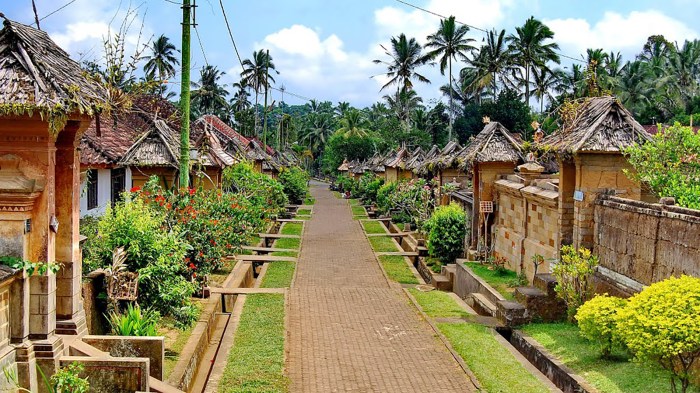
Penglipuran Village’s architecture is a testament to the ingenuity and craftsmanship of its inhabitants. The village’s traditional houses, temples, and public spaces showcase a harmonious blend of traditional Balinese design elements and sustainable construction techniques.
Architectural Features of Penglipuran Village
| Feature | Description |
|---|---|
| Houses | Traditional Penglipuran houses are built on raised platforms and feature thatched roofs, wooden walls, and intricate carvings. The houses are designed to be in harmony with the surrounding environment, with natural ventilation and lighting. |
| Temples | The village has several temples, each dedicated to a different deity. The temples are adorned with intricate carvings and sculptures, and they serve as important gathering places for religious ceremonies and festivals. |
| Public Spaces | Penglipuran Village has several public spaces, including a central courtyard, a meeting hall, and a rice field. These spaces are used for community gatherings, ceremonies, and other activities. |
Significance of Village Layout
The layout of Penglipuran Village reflects traditional Balinese cosmology and social organization. The village is divided into three sections: the northern section is for the living, the central section is for the dead, and the southern section is for the gods.
This layout represents the Balinese belief in the importance of maintaining a balance between the living, the dead, and the divine.
Economic Activities and Livelihoods
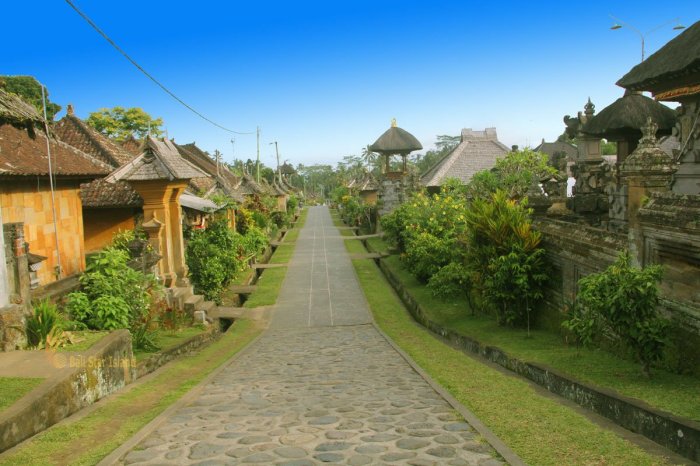
The villagers of Penglipuran primarily rely on traditional crafts, agriculture, and tourism for their livelihoods. Traditional crafts, such as weaving, woodcarving, and bamboo crafts, have been passed down through generations and are a source of pride for the community. Agriculture, including rice cultivation and vegetable farming, provides sustenance and additional income.
In recent years, tourism has become an increasingly important economic activity, with visitors drawn to the village’s unique cultural heritage and natural beauty.
Adaptation to Changing Economic Conditions
Penglipuran has successfully adapted to changing economic conditions while preserving its cultural identity. The village has embraced sustainable tourism practices that minimize environmental impact and respect local traditions. Additionally, the community has established cooperatives and community-based organizations to support local businesses and promote economic development.
These initiatives have helped to ensure that the benefits of tourism are shared equitably among the villagers and that the village’s cultural heritage is preserved.
Role of Cooperatives and Community-Based Organizations, Penglipuran village
Cooperatives and community-based organizations play a vital role in supporting the local economy of Penglipuran. These organizations provide access to resources, training, and marketing opportunities for local businesses. They also work to promote sustainable practices and preserve the village’s cultural heritage.
For example, the Penglipuran Village Tourism Cooperative manages tourism activities in the village, ensuring that they are conducted in a responsible and sustainable manner.
Village Governance and Community Engagement

Penglipuran village is governed by a traditional council known as the “Pekraman”, which is responsible for decision-making and the preservation of cultural traditions. The Pekraman is headed by a “Kelian Adat”, or traditional leader, who is elected by the villagers for a five-year term.
The council also includes representatives from each household, who serve as advisors and assist in the implementation of decisions.
Villagers actively participate in decision-making through regular village meetings, where they discuss issues affecting the community and vote on proposed measures. These meetings are open to all villagers, and their input is highly valued by the Pekraman. Additionally, villagers are encouraged to participate in various community organizations and committees, which focus on specific aspects of village life, such as education, health, and environmental protection.
Challenges and Opportunities
Penglipuran village faces challenges in maintaining its cultural integrity in the face of modernization. The influx of tourism and the influence of modern media have led to some changes in traditional practices and values. However, the village has taken steps to address these challenges by promoting cultural education and awareness among its residents.
The Pekraman has also established regulations to ensure that tourism does not negatively impact the village’s cultural heritage.
Penglipuran village’s commitment to preserving its cultural traditions has presented opportunities for economic development. The village has become a popular tourist destination, attracting visitors from around the world who are interested in experiencing its unique way of life. Tourism has generated income for the villagers and has helped to support the preservation of their cultural heritage.
Wrap-Up
As we bid farewell to Penglipuran Village, we leave with a profound appreciation for the resilience and dedication of its people. Their unwavering commitment to preserving their cultural heritage while embracing sustainable tourism serves as an inspiration to all. May the spirit of Penglipuran continue to thrive, enchanting visitors for generations to come.
FAQ Overview
Where is Penglipuran Village located?
Penglipuran Village is situated in the Bangli Regency of Bali, Indonesia, approximately 45 kilometers northeast of Denpasar.
What is the significance of the bamboo forests in Penglipuran Village?
The bamboo forests surrounding Penglipuran Village play a vital role in the village’s culture and economy. Bamboo is used for construction, handicrafts, and various traditional ceremonies.
How does Penglipuran Village balance tourism with cultural preservation?
The villagers of Penglipuran have implemented eco-friendly practices and tourism guidelines to minimize the impact of tourism on their environment and cultural heritage.